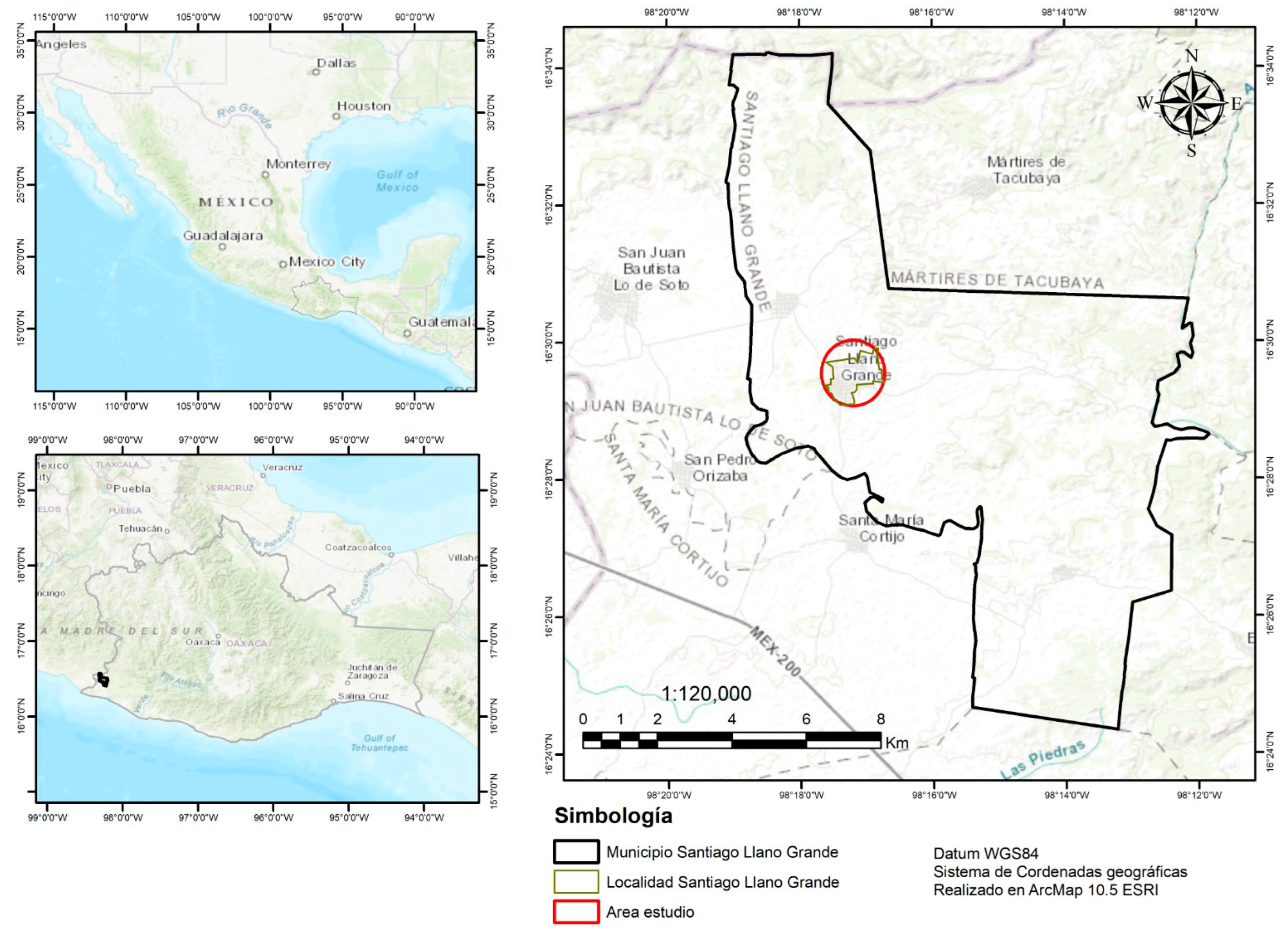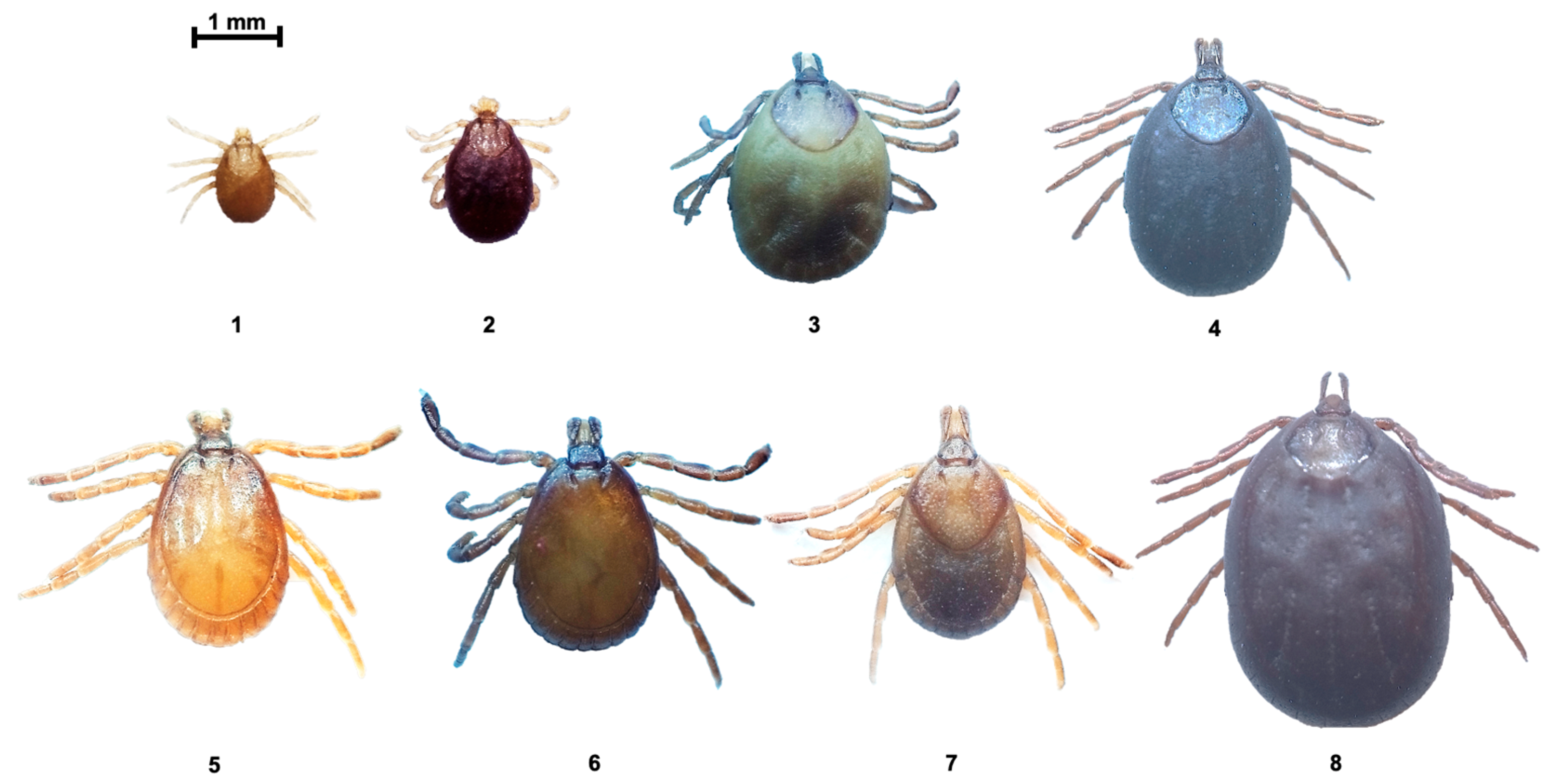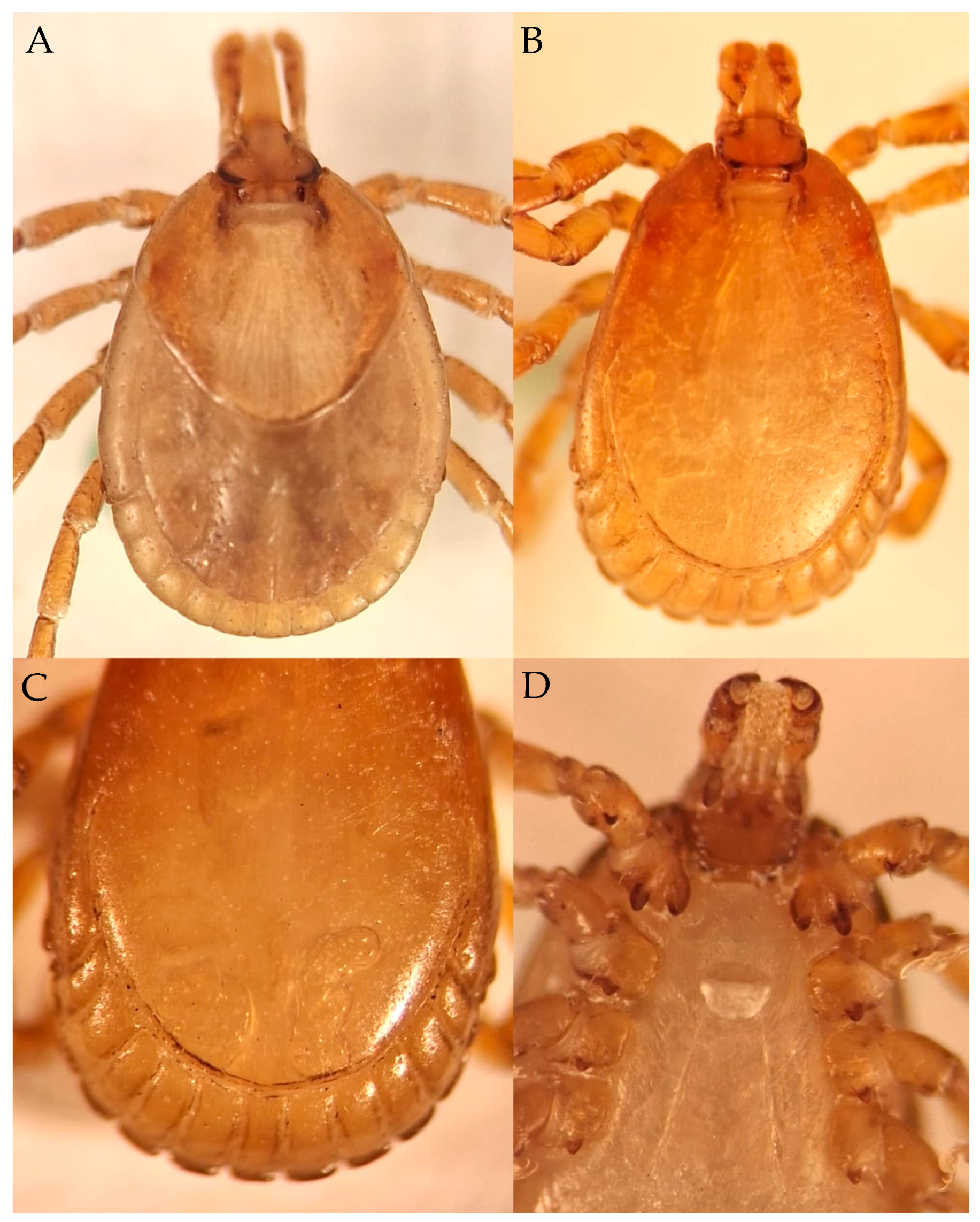Amblyomma auricularium (Acari: Ixodidae) in Nine-Banded Armadillo, Dasypus novemcinctus: A New Record for the Neotropical Region of Mexico
Abstract
:1. Introduction
2. Materials and Methods
3. Results
4. Discussion
5. Conclusions
Author Contributions
Funding
Data Availability Statement
Conflicts of Interest
References
- Conil, P.A. Description d’une nouvelle espèce d’ixode, Ixodes auricularius. Acta Acad. Nac. Cienc. Exactas 1878, 3, 99–110. [Google Scholar]
- Guglielmone, A.A.; Nava, S.; Robbins, R.G. Geographic distribution of the hard ticks (Acari: Ixodida: Ixodidae) of the world by countries and territories. Zootaxa 2023, 5251, 1–274. [Google Scholar] [PubMed]
- Guzmán-Cornejo, C.; Herrera-Mares, A.; Paredes-León, R.; García-Prieto, L. Actualización de la riqueza de garrapatas de los géneros Ixodes y Amblyomma (Ixodida: Ixodidae) en México. Dugesiana 2023, 30, 163–176. [Google Scholar] [CrossRef]
- Guglielmone, A.A.; Robbins, R.G.; Apanaskevich, D.A.; Petney, T.N.; Estrada-Peña, A.; Horak, I.G. The Hard Ticks of the World (Acari: Ixodida: Ixodidae); Springer: New York, NY, USA, 2014; p. 738. [Google Scholar]
- Nava, S.; Venzal, J.M.; Acuña, D.G.; Martins, T.F.; Guglielmone, A.A. Ticks of the Southern Cone of America: Diagnosis, Distribution, and Hosts with Taxonomy, Ecology and Sanitary Importance; Academic Press: London, UK, 2017; p. 348. [Google Scholar]
- Sánchez-Soto, S.; Ramírez-Arenas, C.M.; Esteban-Guzmán, N.; Sánchez-Gómez, W.S. Registro notable de armadillo de cola desnuda, Cabassous centralis (Cingulata: Chlamyphoridae), en el estado de Chiapas, México. Mammal. Notes 2020, 6, 165. [Google Scholar] [CrossRef]
- Julián-Caballero, C.C. Nuevo registro del armadillo de nueve bandas Dasypus Novemcinctus (Cingulata: Dasypodidae) en el municipio de San Antonio Huitepec, Oaxaca, México. Mammal. Notes 2022, 8, 323. [Google Scholar] [CrossRef]
- McBee, K.; Baker, R.J. Dasypus novemcinctus. Mamm. Species 1982, 162, 1–9. [Google Scholar] [CrossRef]
- Whitaker, J.O., Jr.; Morales-Malacara, J.B. Ectoparasites and other associates (Ectodytes) of mammals of Mexico. In Contribuciones Mastozoológicas en Homenaje a Bernardo Villa Instituto de Biología e Instituto de Ecología, Universidad Nacional Autónoma de México; Sánchez-Cordero, V., Medellín, R.A., Eds.; Comisión Nacional para el Uso y Conocimiento de la Biodiversidad (CONABIO): Ciudad de México, México, 2005; pp. 535–666. [Google Scholar]
- SEMARNAT (Secretaría de Medio Ambiente y Recursos Naturales). 2010. Norma Oficial Mexicana NOM-O59-SEMARNAT-2010. Protección Ambiental—Especies Nativas de México de Flora y Fauna Silvestres-Categorías de Riesgo y Especificaciones para su Inclusión, Exclusión o Cambio—Lista de Especies en Riesgo. Ciudad de México: Diario Oficial de la Federación (Segunda Sección). Available online: https://www.dof.gob.mx/normasOficiales/4254/semarnat/semarnat.htm (accessed on 5 January 2025).
- Ávila-Nájera, D.M.; Rosas-Rosas, O.C.; Tarango-Arámbula, L.A.; Martínez-Montoya, J.F.; Santoyo-Brito, E. Conocimiento, uso y valor cultural de seis presas del jaguar (Panthera onca) y su relación con éste, en San Nicolás de los Montes, San Luis Potosí, Mexico. Rev. Mex. Biodivers. 2011, 82, 1020–1028. [Google Scholar] [CrossRef]
- Monroy-Vilchis, O.; Cabrera, L.; Suárez, P.; Zarco-González, M.M.; Rodríguez-Soto, C.; Urios, V. Uso tradicional de vertebrados silvestres en la Sierra Nanchititla, México. Interciencia 2008, 33, 308–313. [Google Scholar]
- López-de Buen, L.; Zárate-Ledesma, F.; Ahuja, C.; Vázquez-Morales, C.; Carrasco, A.; Montiel-Palacios, F. Uso antropogénico, hábitat, abundancia y hábitos alimentarios del armadillo de nueve bandas (Dasypus novemcinctus) en el centro y sur del estado de Veracruz, México. Edentata 2017, 18, 42–50. [Google Scholar] [CrossRef]
- Briceño-Mendez, M.A.; Puc-Kauil, R. Depredación de armadillo (Dasypus novemcinctus) por jaguar (Panthera onca) en México. Cienc. Lat. Rev. Científica Multidiscip. 2021, 5, 4693. [Google Scholar]
- dos Santos, A.R.; Paise, G. Diseases associated with nine-banded armadillo (Dasypus novemcinctus) Dasypodidae consumption: A literature review. In Proceedings of the Congresso Internacional de Conservação de Xenarthra, 1ª edição, Brasilia, Brazil, 30 November 2020. [Google Scholar]
- INEGI. Instituto Nacional de Estadística y Geografía. Compendio de Información Geográfica Municipal de los Estados Unidos Mexicanos Santiago Llano Grande, Oaxaca clave Geoestadística 20474. 2010. Available online: https://www.inegi.org.mx/contenidos/app/mexicocifras/datos_geograficos/20/20474.pdf (accessed on 22 May 2025).
- PMDD. Santiago Llano Grande, Jamiltepec, Oaxaca. Plan Municipal de Desarrollo Rural Sustentable 2008–2010. Eje Ambiental. 2010. Available online: https://www.finanzasoaxaca.gob.mx/pdf/inversion_publica/pmds/08_10/474.pdf (accessed on 22 May 2025).
- USDA. United States Department of Agriculture. Ticks of veterinary importance. In Agriculture Handbook No. 485; 1976. Available online: https://www.govinfo.gov/content/pkg/GOVPUB-A-PURL-gpo27523/pdf/GOVPUB-A-PURL-gpo27523.pdf (accessed on 1 February 2024).
- Guzmán-Cornejo, C.; Robbins, R.G.; Guglielmone, A.A.; Montiel-Parra, G.; Pérez, T.M. The Amblyomma (Acari: Ixodida: Ixodidae) of Mexico: Identification keys, distribution and hosts. Zootaxa 2011, 2998, 16–38. [Google Scholar]
- Martins, T.F.; Labruna, M.B.; Mangold, A.J.; Cafrune, M.M.; Guglielmone, A.A.; Nava, S. Taxonomic key to nymphs of the genus Amblyomma (Acari: Ixodidae) in Argentina, with description and redescription of the nymphal stage of four Amblyomma species. Ticks Tick-Borne Dis. 2014, 5, 753–770. [Google Scholar] [CrossRef] [PubMed]
- Voltzit, O.V. A review of neotropical Amblyomma species (Acari: Ixodidae). Acarina 2007, 15, 3–134. [Google Scholar]
- Bermúdez, S.; Apanaskevich, D.; Domínguez, L. Garrapatas Ixodidae de Panamá; Secretaría Nacional de Ciencia, Tecnología e Innovación: Panamá, Panamá, 2018; p. 129. [Google Scholar]
- Robinson, L.E. Ticks. A Monograph of the Ixodoidea. Part IV. The Genus Amblyomma; Cambridge University Press: London, UK, 1926; p. 302. [Google Scholar]
- Camicas, J.L.; Hervy, J.P.; Adam, F.; Morel, P.C. Les Tiques du Monde (Acarida, Ixodida): Nomenclature, Stades Décrits, Hôtes, Repartition; Orstom: Paris, France, 1998; p. 233. [Google Scholar]
- Keirans, J.E.; Hillyard, P.D. A catalogue of the type specimens of Ixodida (Acari: Argasidae, Ixodidae) deposited in The Natural History Museum, London. Occas. Pap. Syst. Entomol. 2001, 13, 1–74. [Google Scholar]
- Guglielmone, A.A.; Viñabal, A.E. Claves morfológicas dicotómicas e información ecológica para la identificación de garrapatas del género Amblyomma Koch, 1844 de la Argentina. Rev. Investig. Agropecu. 1994, 25, 39–67. [Google Scholar]
- Lahille, F. Contribution à l’étude des ixodidés de la République Argentine. An. Minist. Agric. República Argent. 1905, 2, 1–166. [Google Scholar]
- Boero, J.J. Las Garrapatas de la República Argentina (Acarina: Ixodoidea); Departamento Editorial de la Universidad de Buenos Aires: Buenos Aires, Argentina, 1957; p. 113. [Google Scholar]
- Barros-Battesti, D.M.; Arzua, M.; Bechara, G.H. Carrapatos de Importância Médico-Veterinária da Região Neotropical: Um Guia Ilustrado para Identificação de Espécies; Vox/ICTTD-3/Butantan: São Paulo, Brazil, 2006; p. 223. [Google Scholar]
- Venzal, J.M.; Castro, O.; Guglielmone, A.A.; Keirans, J.E. First records of Amblyomma auricularium (Conil, 1878) and Amblyomma pseudoconcolor Aragão, 1908 (Acari: Ixodidae) from Uruguay. Syst. Appl. Acarol. 2002, 7, 109–111. [Google Scholar] [CrossRef]
- Aragão, H.d.B.; Fonseca, F. Da. Notas de ixodología. V. A propósito da validade de algunas espécies do genero Amblyomma do continente Americano (Acari: Ixodidae). Mem. Inst. Oswaldo Cruz 1953, 51, 485–492. [Google Scholar] [CrossRef]
- Fairchild, G.B.; Kohls, G.M.; Tipton, V.J. The ticks of Panama (Acarina: Ixodoidea). In Ectoparasites of Panama; Field Museum of Natural History: Chicago, IL, USA, 1966; pp. 167–219. [Google Scholar]
- Aragão, H.B. Notas sobre Ixodidas brasileiros. Mem. Inst. Oswaldo Cruz 1911, 3, 145–195. [Google Scholar] [CrossRef]
- Guglielmone, A.A.; Mangold, A.J.; Keirans, J.E. Redescription of the male and female of Amblyomma parvum Aragao, 1908, and description of the nymph and larva, and description of all stages of Amblyomma pseudoparvum sp. n. (Acari: Ixodida: Ixodidae). Acarologia 1990, 31, 143–159. [Google Scholar]
- Guglielmone, A.A.; Petney, T.N.; Mastropaolo, M.; Robbins, R.G. Genera, subgenera, species and subspecies of hard ticks (Acari: Ixodidae) described, named, renamed or given new rank by Paul Schulze (1887–1949) and their current status. Zootaxa 2017, 4325, 1–66. [Google Scholar] [CrossRef]
- Hoffmann, A. Presencia en México de Amblyomma curruca Schulze 1936. An. Esc. Nac. Cien. Biol. 1950, 6, 78–80. [Google Scholar]
- Arana-Guardia, R.; Baak-Baak, C.M.; Cigarroa-Toledo, N.; Reyes-Solis, G.C.; Ojeda-Robertos, N.F.; García-Rejón, J.E.; Zarza, H.; Ceballos, G.; Machain-Williams, C. Ticks (Acari: Ixodidae) from wild mammals in fragmented environments in the south of Yucatan Peninsula, Mexico. Southwest Entomol. 2015, 40, 657–660. [Google Scholar] [CrossRef]
- Rodríguez-Vivas, R.I.; Apanaskevich, D.A.; Ojeda-Chi, M.M.; Trinidad-Martínez, I.; Reyes-Novelo, E.; Esteve-Gassent, M.D.; de León, A.P. Ticks collected from humans, domestic animals, and wildlife in Yucatan, Mexico. Vet. Parasitol. 2016, 215, 106–113. [Google Scholar] [CrossRef]
- Solís-Hernández, A.; Rodríguez-Vivas, R.I.; Esteve-Gasent, M.D.; Villegas-Pérez, S.L. Detección de Borrelia burgdorferi sensu lato en perros y sus garrapatas en comunidades rurales de Yucatán, México. Rev. Biol. Trop. 2018, 66, 428–437. [Google Scholar] [CrossRef]
- Light, J.; Eckerlin, R.E.; Durden, L.A. Checklist of ectoparasites of Canidae and Felidae in Mexico. Therya 2019, 10, 109–119. [Google Scholar] [CrossRef]
- Saraiva, D.G.; Nieri-Bastos, F.A.; Horta, M.C.; Soares, H.S.; Nicola, P.A.; Pereira, L.C.; Labruna, M.B. Rickettsia amblyommii infecting Amblyomma auricularium ticks in Pernambuco, northeastern Brazil: Isolation, transovarial transmission, and transstadial perpetuation. Vector Borne Zoonotic Dis. 2013, 13, 615–618. [Google Scholar] [CrossRef]
- Cohen, E.B.; Auckland, L.D.; Marra, P.P.; Hamer, S.A. Avian migrants facilitate invasions of neotropical ticks and tick- borne pathogens into the United States. Appl. Environ. Microbiol. 2015, 81, 8366–8378. [Google Scholar] [CrossRef]
- Apperson, C.S.; Engber, B.; Nicholson, W.L.; Mead, D.G.; Engel, J.; Yabsley, M.J.; Dail, K.; Johnson, J.; Watson, D.W. Tick-borne diseases in North Carolina: Is “Rickettsia amblyommii” a possible cause of rickettsiosis reported as Rocky Mountain spotted fever? Vector Borne Zoonotic Dis. 2008, 8, 597–606. [Google Scholar] [CrossRef]
- Yen, W.Y.; Stern, K.; Mishra, S.; Helminiak, L.; Sanchez-Vicente, S.; Kim, H.K. Virulence potential of Rickettsia amblyommatis for spotted fever pathogenesis in mice. Pathog. Dis. 2021, 79, ftab024. [Google Scholar] [CrossRef]
- Walker, A.R.; Bouattour, A.; Camicas, J.L.; Estrada-Pena, A.; Horak, I.G.; Latif, A.A.; Pegram, R.G.; Preston, P.M. Ticks of Domestic Animals in Africa: A Guide to Identification of Species; Biosciences Reports: Edinburgh, UK, 2007; p. 21. [Google Scholar]
- Faccini, J.L.; Cardoso, A.C.; Onofrio, V.C.; Labruna, M.B.; Barros-Battesti, D.M. The life cycle of Amblyomma auricularium (Acari: Ixodidae) using rabbits (Oryctolagus cuniculus) as experimental host. Exp. Appl. Acarol. 2010, 50, 71–77. [Google Scholar] [CrossRef] [PubMed]



| Host | Total Ticks | Nymphs | Females | Males | ||||
|---|---|---|---|---|---|---|---|---|
| Uf | SE | E | Uf | SE | E | |||
| 1 | 5 | - | - | - | 1 | 2 | 1 | 1 |
| 2 | 6 | - | 1 | - | - | - | - | 5 |
| 3 | 7 | - | 1 | - | - | - | - | 6 |
| 4 | 14 | 3 | 2 | - | 1 | 2 | 1 | 5 |
| 5 | 15 | - | - | 1 | 6 | 2 | - | 6 |
| 1 | 5 | - | - | - | 1 | 2 | 1 | 1 |
| Total | 52 | 3 | 4 | 1 | 9 | 8 | 3 | 24 |
Disclaimer/Publisher’s Note: The statements, opinions and data contained in all publications are solely those of the individual author(s) and contributor(s) and not of MDPI and/or the editor(s). MDPI and/or the editor(s) disclaim responsibility for any injury to people or property resulting from any ideas, methods, instructions or products referred to in the content. |
© 2025 by the authors. Licensee MDPI, Basel, Switzerland. This article is an open access article distributed under the terms and conditions of the Creative Commons Attribution (CC BY) license (https://creativecommons.org/licenses/by/4.0/).
Share and Cite
González-Álvarez, V.H.; Prudente-Peláez, E.; Díaz-Vargas, L.Á.; Ayala-Monter, M.A.; Alvarado-Rodríguez, G.; Guzmán-Cornejo, C. Amblyomma auricularium (Acari: Ixodidae) in Nine-Banded Armadillo, Dasypus novemcinctus: A New Record for the Neotropical Region of Mexico. Arthropoda 2025, 3, 9. https://doi.org/10.3390/arthropoda3020009
González-Álvarez VH, Prudente-Peláez E, Díaz-Vargas LÁ, Ayala-Monter MA, Alvarado-Rodríguez G, Guzmán-Cornejo C. Amblyomma auricularium (Acari: Ixodidae) in Nine-Banded Armadillo, Dasypus novemcinctus: A New Record for the Neotropical Region of Mexico. Arthropoda. 2025; 3(2):9. https://doi.org/10.3390/arthropoda3020009
Chicago/Turabian StyleGonzález-Álvarez, Vicente Homero, Elena Prudente-Peláez, Luis Ángel Díaz-Vargas, Marco Antonio Ayala-Monter, Gabriela Alvarado-Rodríguez, and Carmen Guzmán-Cornejo. 2025. "Amblyomma auricularium (Acari: Ixodidae) in Nine-Banded Armadillo, Dasypus novemcinctus: A New Record for the Neotropical Region of Mexico" Arthropoda 3, no. 2: 9. https://doi.org/10.3390/arthropoda3020009
APA StyleGonzález-Álvarez, V. H., Prudente-Peláez, E., Díaz-Vargas, L. Á., Ayala-Monter, M. A., Alvarado-Rodríguez, G., & Guzmán-Cornejo, C. (2025). Amblyomma auricularium (Acari: Ixodidae) in Nine-Banded Armadillo, Dasypus novemcinctus: A New Record for the Neotropical Region of Mexico. Arthropoda, 3(2), 9. https://doi.org/10.3390/arthropoda3020009







